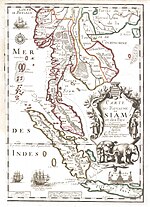
Back مملكة ثونبوري Arabic تونبوری شاهلیغی AZB Тханбуры (каралеўства) BE Království Thonburi Czech Königreich Thonburi German Reino de Thonburi Spanish پادشاهی تونبوری FA Royaume de Thonburi French Kerajaan Thonburi ID Regno di Thonburi Italian
Thonburi Kingdom | |||||||||||||||||
|---|---|---|---|---|---|---|---|---|---|---|---|---|---|---|---|---|---|
| 1767–1782 | |||||||||||||||||
 Sphere of influence of the Thonburi Kingdom in 1780; early modern Southeast Asian political borders are subject to speculation | |||||||||||||||||
| Capital | Thonburi | ||||||||||||||||
| Common languages |
| ||||||||||||||||
| Religion |
| ||||||||||||||||
| Government | Mandala kingdom | ||||||||||||||||
| Monarch | |||||||||||||||||
• 1767–1782 | Taksin | ||||||||||||||||
| Viceroy | |||||||||||||||||
• –1782 | Inthraphithak | ||||||||||||||||
| Historical era | Early modern era | ||||||||||||||||
| January 1767 | |||||||||||||||||
• Coronation of Taksin the Great | 28 December 1767 | ||||||||||||||||
• Capture of Nakhon Si Thammarat | 21 September 1769 | ||||||||||||||||
• Capture of Phitsanulok | 8 August 1770 | ||||||||||||||||
• Capture of Chiang Mai | 14 January 1775 | ||||||||||||||||
• Fall of Phitsanulok | 15 March 1776 | ||||||||||||||||
• Capture of Vientiane | March 1779 | ||||||||||||||||
• Recognition by the Qing dynasty | 1781–1782 | ||||||||||||||||
• Deposition of Taksin | 1 April 1782 | ||||||||||||||||
| Currency | Photduang | ||||||||||||||||
| |||||||||||||||||
| Today part of | |||||||||||||||||
| History of Thailand |
|---|
 |
|
|
The Thonburi Kingdom[i][2] was a major Siamese kingdom which existed in Southeast Asia from 1767 to 1782, centered around the city of Thonburi, in Siam or present-day Thailand. The kingdom was founded by Taksin the Great, who reunited Siam following the collapse of the Ayutthaya Kingdom, which saw the country separate into five warring regional states. The Thonburi Kingdom oversaw the rapid reunification and reestablishment of Siam as a preeminient military power within mainland Southeast Asia, overseeing the country's expansion to its greatest territorial extent up to that point in its history, incorporating Lan Na, the Laotian kingdoms (Luang Phrabang, Vientiane, Champasak), and Cambodia under the Siamese sphere of influence.[3]
The Thonburi Kingdom saw the consolidation and continued growth of Chinese trade from Qing China, a continuation from the late Ayutthaya period (1688-1767), and the increased influence of the Chinese community in Siam, with Taksin and later monarchs sharing close connections and close family ties with the Sino-Siamese community.
The Thonburi Kingdom lasted for only 14 years, ending in 1782 when Taksin was deposed by a major Thonburi military commander, Chao Phraya Chakri, who subsequently founded the Rattanakosin Kingdom, the fourth and present ruling kingdom of Thailand.
- ^ Lieberman, Victor (2003). Strange Parallels: Volume 1, Integration on the Mainland: Southeast Asia in Global Context, c.800–1830 (Studies in Comparative World History) (Kindle ed.). Cambridge University Press. ISBN 978-0521800860.
- ^ Wyatt, David K. (1 January 2003). Thailand: A Short History. Yale University Press. p. 122. ISBN 978-0-300-08475-7.
- ^ Wyatt, David K. (2003). Thailand : A Short History (2nd ed.). Chiang Mai: Silkworm Books. p. 122. ISBN 974957544X. "Within a decade or so, a new Siam already had succeeded where Naresuan and his Ayutthaya predecessors had failed in creating a new Siamese empire encompassing Lan Na, much of Lan Sang [sic], as well as Cambodia, and large portions of the Malay Peninsula."
Cite error: There are <ref group=lower-roman> tags or {{efn-lr}} templates on this page, but the references will not show without a {{reflist|group=lower-roman}} template or {{notelist-lr}} template (see the help page).
